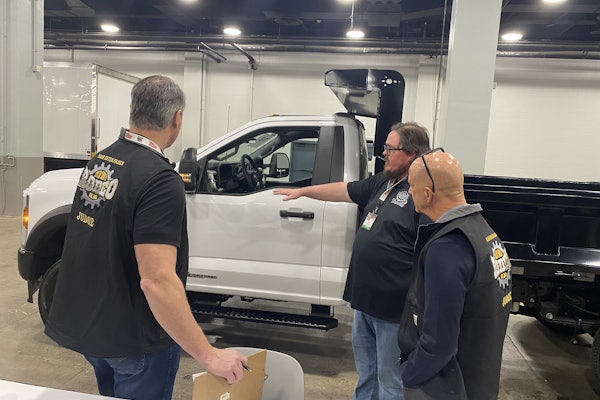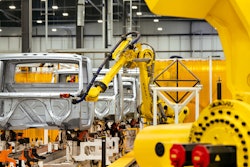They are already a four-wheel staple on the highways, and they are increasingly entering the commercial vehicle market. With fleets looking to reduce costs through greater fuel efficiency and improve their image as environmentally conscious carriers, hybrids are gaining in popularity. Most every medium- and heavy-duty truck manufacturer offers them and while not yet in widespread production, that is changing. Economic incentives such as the Energy Policy Act of 2005, which provides tax credits for hybrid commercial trucks of up to $12,000 per unit, make them that much more financially attractive.
This means they will, sooner rather than later, make their way into the aftermarket support network. Here’s what you can expect in hybrid offerings from major truck manufacturers that are, or soon will be, in production.
Freightliner – Business Class M2e Hybrid
Backed by the technological experience of Daimler AG, a leading manufacturer of hybrid commercial vehicles, the Freightliner Business Class M2e Hybrid is an efficient, economical and ecological choice for stop-and-go operations, says the company.
The Freightliner Business Class M2e Hybrid is said to reduce fuel consumption compared to non-hybrid drivetrain systems. Testing shows a savings of up to 1,500 gallons of fuel per year for typical urban delivery applications, according to the company.
It also is said to significantly lower carbon dioxide, nitrous oxide and particulate emissions, as well as increase engine and brake life by more than 100 percent. The vehicle also is quiet, benefiting neighborhood operation. Mounted equipment, such as buckets and lifts, run from an electric Power Take-Off (ePTO) without noisy idling.
It features the Eaton Hybrid Electric Drive System, a parallel electric hybrid system that enables drivers to either use the diesel engine alone or operate in combination with the hybrid electric motor. The hybrid motor provides additional power to launch the vehicle and improves fuel economy.
The Freightliner Business Class M2e Hybrid can be configured for a variety of applications, including utility, pick up and delivery, beverage, landscape, leasing, government and towing.
IC Bus – Hybrid School Bus
IC Bus hybrid school buses can double fuel efficiency and reduce emissions of particulate matter by up to 90 percent, says the company. Currently, there are more than 15 IC-branded hybrid school buses operating in the U.S. and Canada, with more orders expected.
The school buses are plugged in at night, charging the electric motor that is part of the hybrid system. The electric motor and the diesel engine work together during operation, which results in lower emissions and increased fuel efficiency. Fuel savings are said to be 800 gallons annually per bus, resulting in a financial savings of $3,000 annually per bus.
IC also showcased its first hybrid commercial bus – the CE Hybrid Series – in Chicago in October 2006. The company has since launched additional models of this platform, including a new version at the BusCon Show last month.
International – DuraStar Hybrid
International is the first company to enter full-line production of commercial hybrid trucks and have more than 200 in customer use, says the company.
The International DuraStar Hybrid is said to have the ability to provide fuel savings of 30 to 40 percent in many applications. Fuel efficiency can increase to more than 60 percent in utility-type applications. Diesel emissions are completely eliminated when the hybrid truck operates equipment (such as overhead utility booms) solely on the truck’s battery power, instead of allowing the engine to idle.
Navistar also partnered with the Environmental Protection Agency, the U.S. Army, UPS and Eaton Corporation to develop the first series of diesel hydraulic hybrid urban delivery vehicles.
Last year, Navistar received the 2007 Blue Sky Award from WestStart-CALSTART, the nation’s leading advanced transportation technology organization, for its contributions to the commercial development of diesel hybrid technology.
According to the company, its hybrid trucks have a fuel savings of 1,000 gallons annually per unit and provide financial savings of almost $4,000 each year.
Kenworth – Class 6 T270 and Class 7 T370
Kenworth offers the fuel-efficient, hybrid option on its Class 6 T270 and Class 7 T370 conventional models. Kenworth says its goal is to enhance fuel economy by up to 30 percent in pick up and delivery applications and up to 50 percent in utility operations.
The Kenworth hybrids use an integral transmission-mounted motor/generator; frame-mounted 340-volt, lithium-ion battery pack; and a dedicated power management system. Advanced powertrain controls monitor driving conditions and automatically select the ideal power mode, smoothly switching among electric only, combined diesel and electric and diesel only, says the company.
Electricity generated through regenerative braking is stored and used for acceleration, assisting the diesel engine. The hybrid system is monitored through a dash display.
Purchasers of Kenworth hybrids equipped with a Paccar PX-6 engine and the Eaton hybrid system may qualify for a maximum federal tax credit of $6,000 (Class 6) and $12,000 (Class 7).
Mack Trucks – TerraPro Low Entry
The Mack TerraPro Low Entry refuse truck was built under contract for the U.S. Air Force and will be placed into operation later this year in Macon, Ga. This is the fifth hybrid Mack has built for the USAF. The others are in operation around the country.
The company’s hybrid technology is said to provide fuel economy improvements of 30 to 50 percent in refuse applications. The vehicles are also quieter than conventional trucks, which is a benefit for neighborhood trash removal.
The Mack hybrid electric powertrain features an integrated starter, alternator and motor referred to collectively by the company as an electric machine. The electric machine assists the TerraPro’s Mack MP7 diesel engine in providing torque to the wheels and regenerates energy during braking. The energy captured during braking (stored as electricity in lithium ion batteries) is then used in place of diesel fuel and helps launch the truck from stops.
This technology provides the maximum fuel savings on routes with frequent braking and acceleration, says the company. Other applications suited for this technology include urban delivery routes and certain construction work.
Peterbilt – Models 330, 335 HEV and Model 320 HLA
In August, Peterbilt announced full production availability of its two medium-duty hybrid electric vehicles. The company says its Class 6 Model 330 and Class 7 Model 335 hybrid electric vehicles increase fuel savings, reduce emissions and provide high quality and performance.
The vehicles provide an increase in fuel efficiency with more than 30 percent improvement in pick up and delivery applications and gains of up to 50 percent in utility applications, says the company. This fuel efficiency results in up to 2,400 gallons of diesel saved annually, per vehicle.
These two models reduce greenhouse gases through the reduction of vehicle tailpipe emissions of hydrocarbons, carbon monoxide and oxides of nitrogen (NOx).
The Class 6 Model 330 hybrid provides a non-CDL option to accommodate a wider range of drivers and is ideal for short-haul pick up and delivery applications. The Class 7 Model 335 hybrid is ideal for pick up and delivery, beverage distribution and municipal and utility operations, says Peterbilt. Both vehicles are equipped with the Paccar PX-6 engine. Additionally, both vehicles qualify for U.S. federal tax incentives of up to $12,000.
The second hybrid platform is the Model 320 Hydraulic Launch Assist (HLA) that goes into full production this winter. Peterbilt’s low-cab-forward Model 320 HLA is designed for vocational stop-and-go applications, such as refuse collection, and utilizes HLA technology developed by Eaton Corporation exclusively for Paccar.
The system captures the trucks kinetic energy during braking to assist in launching and accelerating the vehicle. Testing has proven a significant improvement in fuel economy, and indicated the potential to reduce annual brake re-alignment services by 50 percent, says the company.
Hydraulic launch assist technology works by recovering up to 75 percent of the energy normally lost as heat by the vehicle’s brakes in the form of pressurized hydraulic fluid. This fluid is stored in an on-board accumulator until the driver next accelerates the vehicle.
In “fuel economy mode,” savings occur when stored energy is used to launch the vehicle followed seamlessly by power from the primary engine. In “performance mode,” the stored energy is released and blended with engine power at launch. Here, a double-digit savings in fuel economy can be realized, along with an 18 percent improvement in acceleration, says the company.








